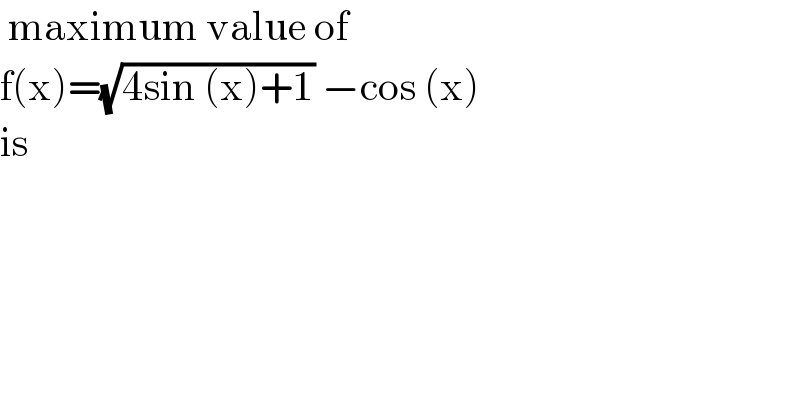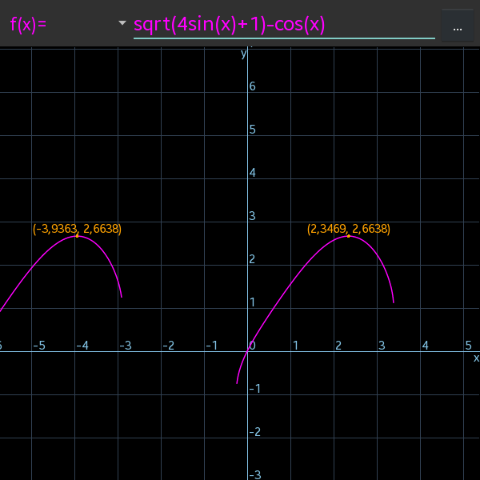
Question Number 132474 by bemath last updated on 14/Feb/21

$$\:\mathrm{maximum}\:\mathrm{value}\:\mathrm{of}\: \\ $$$$\mathrm{f}\left(\mathrm{x}\right)=\sqrt{\mathrm{4sin}\:\left(\mathrm{x}\right)+\mathrm{1}}\:−\mathrm{cos}\:\left(\mathrm{x}\right) \\ $$$$\mathrm{is}\: \\ $$
Commented by EDWIN88 last updated on 14/Feb/21

Commented by bemath last updated on 14/Feb/21

$$\mathrm{approximation} \\ $$
Answered by mr W last updated on 14/Feb/21

$$\frac{{df}\left({x}\right)}{{dx}}=\frac{\mathrm{2}\:\mathrm{cos}\:{x}}{\:\sqrt{\mathrm{4}\:\mathrm{sin}\:{x}+\mathrm{1}}}+\mathrm{sin}\:{x}=\mathrm{0} \\ $$$$\frac{\mathrm{4}\:\mathrm{cos}^{\mathrm{2}} \:{x}}{\:\mathrm{4}\:\mathrm{sin}\:{x}+\mathrm{1}}=\mathrm{sin}^{\mathrm{2}} \:{x} \\ $$$$\frac{\mathrm{4}\left(\mathrm{1}−\mathrm{sin}^{\mathrm{2}} \:{x}\right)}{\:\mathrm{4}\:\mathrm{sin}\:{x}+\mathrm{1}}=\mathrm{sin}^{\mathrm{2}} \:{x} \\ $$$$\mathrm{4sin}^{\mathrm{3}} \:{x}+\mathrm{5}\:\mathrm{sin}^{\mathrm{2}} \:{x}−\mathrm{4}=\mathrm{0} \\ $$$$\frac{\mathrm{1}}{\mathrm{sin}^{\mathrm{3}} \:{x}}−\frac{\mathrm{5}}{\mathrm{4}\:\mathrm{sin}\:{x}}−\mathrm{1}=\mathrm{0} \\ $$$$\Delta=\left(−\frac{\mathrm{1}}{\mathrm{2}}\right)^{\mathrm{2}} +\left(−\frac{\mathrm{5}}{\mathrm{12}}\right)^{\mathrm{3}} =\frac{\mathrm{307}}{\mathrm{1728}}>\mathrm{0} \\ $$$$\Rightarrow\frac{\mathrm{1}}{\mathrm{sin}\:{x}}=\frac{\mathrm{1}}{\mathrm{2}}\left(\sqrt[{\mathrm{3}}]{\frac{\sqrt{\mathrm{921}}}{\mathrm{9}}+\mathrm{4}}−\sqrt[{\mathrm{3}}]{\frac{\sqrt{\mathrm{921}}}{\mathrm{9}}−\mathrm{4}}\right) \\ $$$$\Rightarrow\mathrm{sin}\:{x}=\frac{\mathrm{2}}{\:\sqrt[{\mathrm{3}}]{\frac{\sqrt{\mathrm{921}}}{\mathrm{9}}+\mathrm{4}}−\sqrt[{\mathrm{3}}]{\frac{\sqrt{\mathrm{921}}}{\mathrm{9}}−\mathrm{4}}} \\ $$$$\mathrm{cos}\:{x}=\pm\sqrt{\mathrm{1}−\mathrm{sin}^{\mathrm{2}} \:{x}} \\ $$$${f}\left({x}\right)_{{max}} =\sqrt{\mathrm{4}\:\mathrm{sin}\:{x}+\mathrm{1}}+\sqrt{\mathrm{1}−\mathrm{sin}^{\mathrm{2}} \:{x}}\approx\mathrm{2}.\mathrm{663}\:\mathrm{815}\:\mathrm{973} \\ $$
